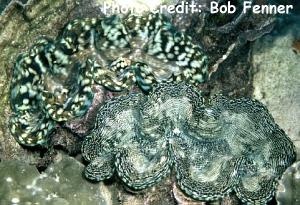
By Bob Goemans


Likely Reef Tank Suitable
Likely Fish-Only Tank Suitable
The giant clams (bivalves) of real interest fall into two genera; those being Tridacna and Hippopus. Of the nine known species of giant clams, Tridacna maxima, T. derasa, T. gigas, T. crocea, T. squamosa, and Hippopus hippopus are the most widely kept in aquaria. Tridacna mbalavuana and Hippopus porcellanus are rarely seen in the trade. As for T. rosewateri, the ninth in the family, which is not mentioned below, information and a photo of it still escapes me. If you have either on this species, please forward it to me so it can be posted here.
The two shells that form their enclosure are hinged and held together by a powerful muscle. Size ranges from 6.5 inches (16 cm) to approximately three feet (1 m), such as T. gigas, which has been recorded up to 53 inches (132 cm). They are mostly very colorful and fairly easy to maintain and have become very popular, besides somewhat expensive. However, Tridacna clams from various mariculture farms are finding their way into the aquarium market and prices for these beauties are starting to become reasonable once again.
The more colorful clams are naturally found throughout the Indo-Pacific area high up on reef areas where there is intense light and excellent water movement. Those in fairly shallow areas have a highly pigmented mantle that shields them against damaging UV. In fact, the protective blue, green, yellow, and brown hues of their mantles indicate the more shallow water species. The olive-green mantle of T. Gigas and H. hippopus indicate deeper water specimens.
They have primitive "eye spots" along the mantle's outer edges that can detect changes in light intensity. Strong water movement brings suspended particles and nutrients. At the same time its zooxanthellae, via photosynthesis, utilize a portion of the clam's own waste products for food and in return the algae waste products provide a natural food source, i.e., carbohydrates/glycerol. These clams make about 90% of their own food requirements. Their dinoflagellate zooxanthellae have been identified as Gymnodinium microadriaticum and excess cells also serve as a food supply.
The mantle has two openings, one is an inlet siphon and the other is the outlet siphon. Water and some water borne nutrients enter the clam through the inlet siphon, which is slit-like in the mantle. Excess water and waste are expelled through the tube-like outlet siphon also located in the mantle.
Adequate lighting, e.g., about six hours per day, is extremely important in the health of these miniature algae scrubbers. Excellent lighting, good water movement, properly dosed calcium, strontium, and iodine additions will provide long term success with these giant clams. Even though juvenile clams generally require less light because they have thinner tissue, it is better to place them where they will not have to be moved in the future.
There's a small white cone-shaped snail, Pyramidellidae sp. that feeds upon Tridacna clams. It can multiply quickly at a very young age, and in large numbers can be a serious threat to any clams in the aquarium. Typically, they can be found along the clams upper edge where the mantle overhangs, especially during evening hours. During the daytime, they may be located at the foot area or tucked away along the ridges on the shell. There is also another snail predator, Cymatium muricinum, that clam keepers should be aware of. It enters the clam through the byssal opening and after consuming the juices inside the clam and killing it, then moves on to other clams. Click on their names here in this paragraph for photos of these devastating snails and visit the section on 'Snails' in this part of my library for more information. As for other clam predators, be forewarned, bristleworms, starfish, and crabs are also a danger!
Keep in mind some of these clams attach themselves firmly to a substrate surface with special "byssal" threads, generally referred to as a "foot." If you are not sure of the placement of a new clam, always place it on some loose gravel, possibly in small gravel filled dish until the permanent location is decided. Once attached to a rock, never simply pull them off. To remove, use a credit card or razor blade to cut the byssal threads as close to the surface/rock as possible.
The least expensive and most hardiest is T. derasa. The Tridacna clams gigas, squamosa, maxima, and crocea are also hardy, with the maxima and crocea the most popular because of their beautiful colors. For more information about these beautiful animals visit www.aquasearch.net.au/.
FYI - Charles Delbeek responded to a reader's comment in the April 2010 issue of Aquarium Fish International that his Tridacna crocea clam mantles were beginning to pinch inwards. The reader also added other clams in the aquarium were also seemly affected by this strange happening and eventually their mantles pulled away from their shells and were lost. He questioned why. Charles responded by saying the symptom called 'pinched mantle' is believed to be caused by a ciliated protozoan called 'Perkinsus marinus' and that when first seen a freshwater bath of similar pH, alkalinity and temperature for five minutes or less is recommended. I suggest reading this entire article, as its quite enlightening!